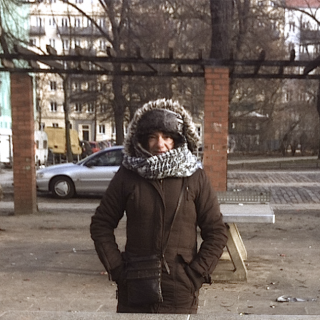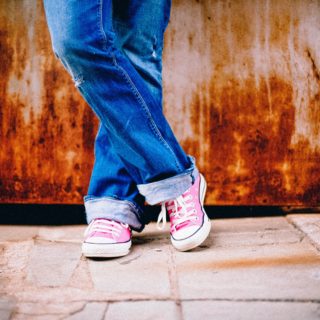The 8-year-old girl who saw her father beheaded in Iraq. The little boy who was a child soldier in Kenya and promised he would never kill anyone again. Children and teachers who survived an attack on a day care in the interior of Minas Gerais (a state in southeast Brazil). These people have something in common: they have endured tragedy. Some people avoid intimate knowledge of such catastrophes, while others help. São Paulo’s Reinaldo Nascimento, 39, is one who helps. Nascimento is one of the founders of Associação da Pedagogia de Emergência, an organization helping survivors through the first days of the aftermath of a tragic event. Most of those survivors are children, and the association helps them deal with the trauma they have experienced.
Nascimento, who was born and raised in suburban São Paulo, is a physical educator who has studied social therapy in Germany. His work includes traveling to countries enduring conflict and natural disaster, such as Kenya, Iraq, Nepal, Haiti, Lebanon, Ecuador and Mexico. In his luggage, he carries some paper, scissors, and color pens. All these materials are used in activities that encourage people to express feelings without having to talk about what they have suffered. If they wish, they can simply draw, listen to stories, make collages, sing, and dance.
Nascimento also talked about about working in Brazil. “It’s difficult because, unlike in Iraq and Kenya, for instance, war is not declared here,” he says. “In those places, people talk about it. Not here. Brazilian people think they cannot talk about problems. Everybody has to be a superhero.” Reinaldo lives in São Paulo and talked to Believe.Earth about the most significant moments of his work and how games and art restore victims’ desire for better days.
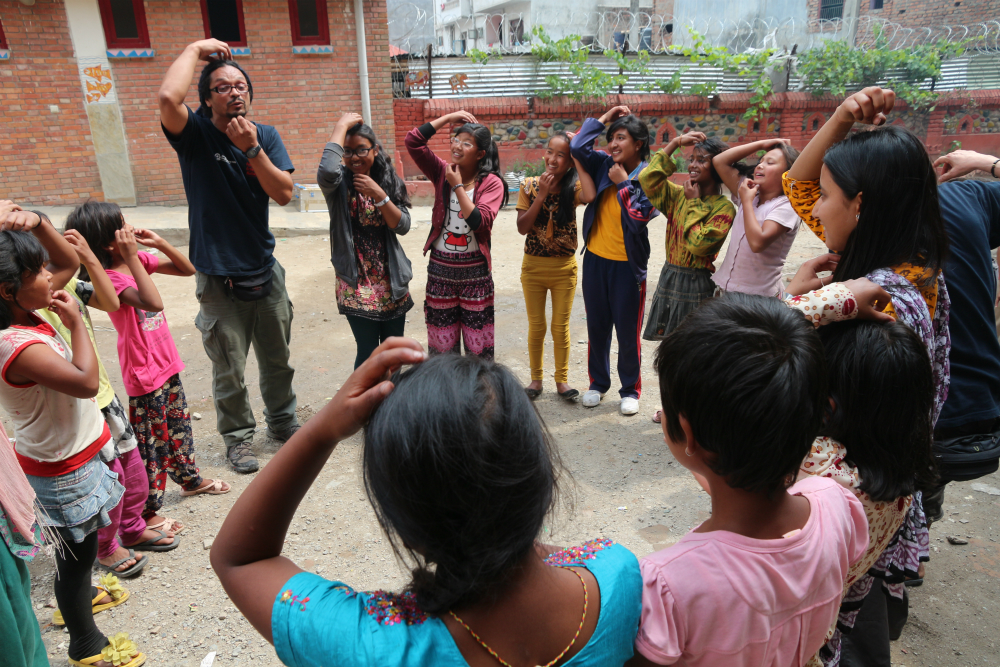
Nascimento playing with children in Nepal after an earthquake hit the region in 2015 (Reinaldo Nascimento/Personal Archive)
Believe.Earth (BE) – How was your first mission with traumatized children?
Reinaldo Nascimento (RN) – It was in a camp in Kenya, hosting refugees from neighboring countries, in 2012. A place for 30,000 people but there were already more than 200,000. I embraced the mission and thought, “Nothing can be worse than Brazil.” After all, I was born in a slum. But, we know nothing. When I arrived there, it was scary: Much harder than living in a slum. I understood what vulnerability means. I saw children left totally abandoned, no bath for weeks, or any type of care. I wondered what kind of future they would have. I remember a little boy who wore the same Neymar t-shirt the whole time I was there, about 15 to 20 days. It was a hopeless situation. The drought didn’t cease, wars only worsened in the region, and there was violence and sexual abuse within the camp.
BE – How did you react?
RN – It was really hard. There was a boy who wanted me to adopt him. He had been a child soldier and promised never to kill anyone again. From that moment on, I began rethink everything in my life: “Why do I have two radios?” On the other hand, I was honored and grateful for the opportunity to be there with those children. I noticed that games and activities could really help the young ones to get out of that traumatic experience and enjoy their childhood, even in that setting.
BE – What other remarkable moments follow you?
RN – I will never forget an 8-year-old girl I met in Iraqi Kurdistan. She had seen her father beheaded. At first, she didn’t want to interact with anyone. But, when she decided to join our group — we had formed a circle and were playing games — she started warming up. After half an hour, she asked me to sing. You could clearly see her face relaxing, her inflexibility had disappeared. There was also a boy in Lebanon who was tough. One day, I thought, “I’ll look after this kid.” I decided to massage his shoulder and he began relaxing. The other day, he asked for more massage, and promised me that he would behave well. I told him he could do whatever he wanted. Later, he started taking part in the games.
BE – Is there any activity that works better with children who have gone through a specific situation, but is not so effective with other kids?
RN – It can be weird to say this, but the best scenario for me is when kids and teens start complaining about my games. I’m very happy because I know that their games will always be better than mine. But, as they’re involved in lots of traumas, they cannot simply play. In general, it takes four days for them to start complaining about what I proposed and give ideas. In the end, I learn a lot. The games they suggest are much more healing than mine because, instead of talking about war, they tell us about games they’ve learned with their parents. They find what they need and what makes sense to them, what helps them deal with the trauma and move forward.
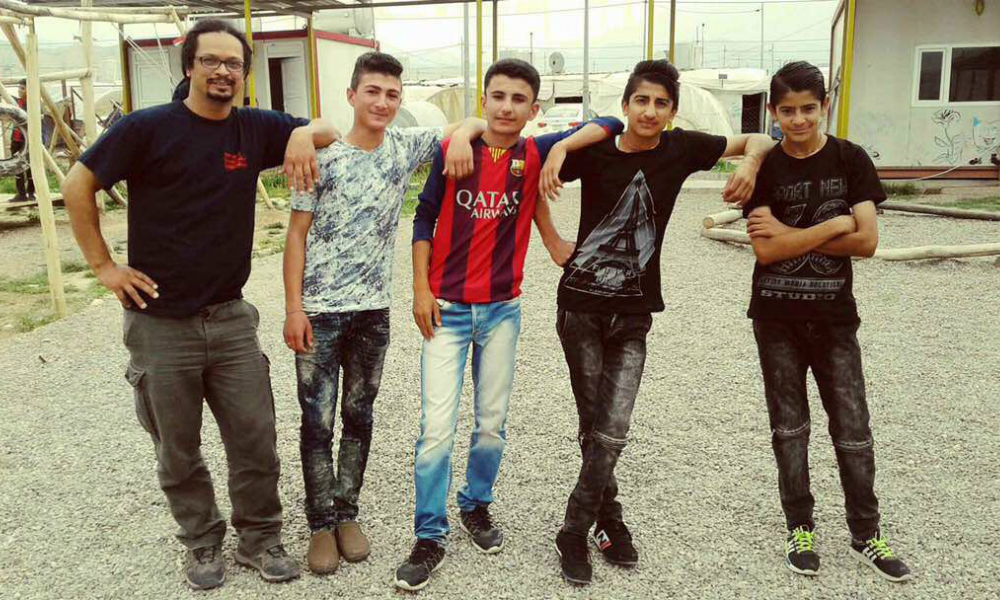
Nascimento with boys from Iraqi Kurdistan: Children and teens often resist activities at first, but they soon join in (Reinaldo Nascimento/Personal Archive)
BE – Why do you think games work better than a conversation about the traumas they experienced?
RN – For some people, talking about trauma means getting traumatized again. We see children who want to play games acting out killing others and we know that it is not good for them, because they are experiencing what they’ve witnessed. When I see a child who draws pictures of violence, I start asking questions like, “Didn’t you tell me you lived on a mountain?” or “Didn’t you tell me your father raises cattle?” Soon after, the drawings start changing.
BE – But isn’t that sugar-coating things?
RN – Not at all. Because children are not talking about what they’ve experienced, but they’re expressing themselves through other means, such as music, art, and sport. Bernd Ruf [a German teacher and creator of Emergency Pedagogy] says that if the tension does not dissipate, the healing process is muddled. So, when children express themselves through art, the wound is still there, but the tension is easing. For example, while they cut paper and make collage, they can talk if they want. They often talk because they feel valued — someone is giving them attention. But, nothing is imposed. Soon, the results come. Because of this process, some parents tell us that their children are sleeping better.
BE – Teachers you worked with, after an earthquake in Mexico, said in a video that they had fewer nightmares. What is the influence of this pedagogical approach on sleep?
RN – Trauma results in a loss of rhythm. The body gets discouraged because you don’t have to wake up early, work, go to school, sleep at a specific time, as you don’t know what will happen the next day. So, on our first day of work, we immediately created a weekly schedule for these groups, a routine. We also taught them a song. Many reported that, instead of thinking of the tragedy at night, they thought about and learned the lyrics of the song by heart. Besides that, people who have been seeing risk in everything due to a trauma, when they are in a safe place, disconnect their internal alarm.

Reinaldo Nascimento at Associação Comunitária Monte Azul in suburban São Paulo, where he studied and taught classes (Junior Sá/Believe.Earth)
BE – How can you tell that the victims are experiencing that state of alarm or trauma?
RN – It differs from one person to another. It’s common for children, even very small ones, to draw scenes in which they appear with no hands. This reflects how incapable they feel. I saw the same situation in Rocinha (a famous slum in Rio de Janeiro).
BE – Why is it preferable for victims to go through the Emergency Pedagogy program between four and eight weeks after the trauma?
RN – Because the wound is only covered by a ‘band-aid’ when not healed. You cannot remove it fast as it’ll be painful. Healing is a time-consuming process. In Nepal, most children only needed the program just after the earthquake. On the other hand, in Rocinha, trauma has lasted years and even decades because the trauma comes from parents and grandparents. Generations repeating the same sentence: “When I was young it used to be worse and now I’m here. Stop crying.” Generations of unhealed trauma.
BE – Is this related to your childhood?
RN – I guess so. When I was 11, I used to live in Jardim Angela [a district in southern São Paulo]. I saw a murder and no one asked me how I was feeling after that. I was just told not to talk about it. It’s happened to many children. Everything gets worse because violence often comes from those who should protect us: Our parents, the police, etc.
BE – Is it harder for you to work in Brazil?
RN – Yes, but this is my dream. It is difficult because, unlike in Iraq and Kenya, war is not declared in Brazil. In those places, people talk about it. Not here. Brazilian people think they cannot talk about problems, or they’ll be considered weak people. Everyone must be a superhero – this is the most painful thing. In Brazilian slums, the problem is no longer an emergency because violence has lasted for a long time. These are very old wounds.
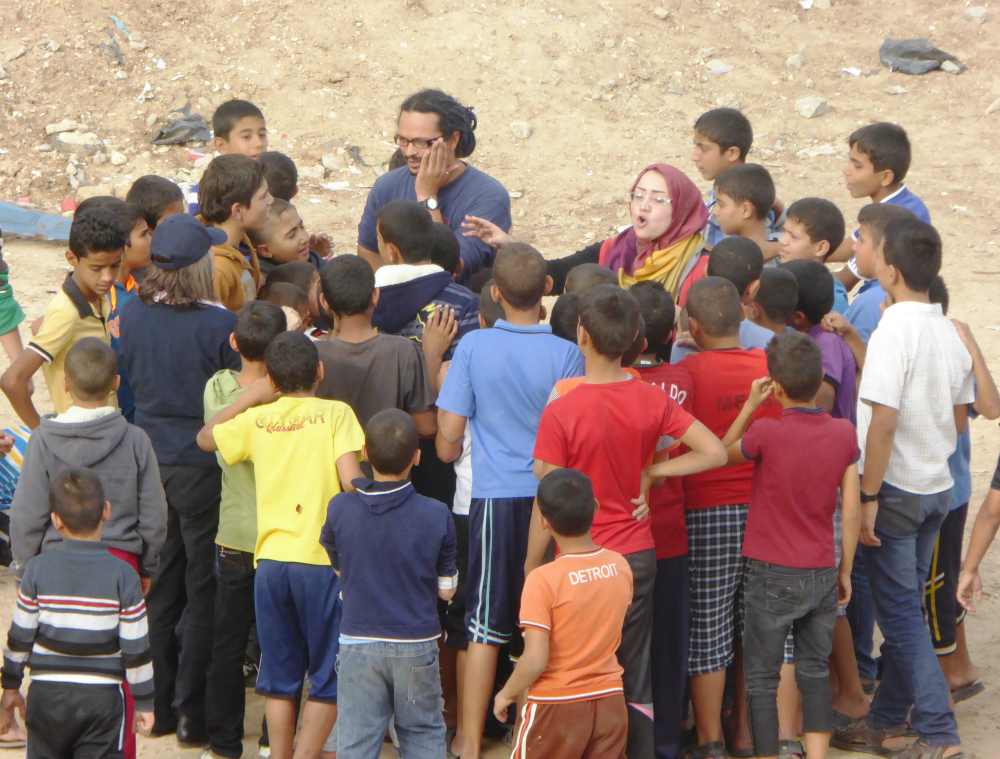
Beginning an Emergency Pedagogy intervention in the Gaza Strip in 2014 (Reinaldo Nascimento/Personal Archive)
BE – How was it at the day care in Janaúba, Minas Gerais, where a security guard set fire to children?
RN – We could talk to everybody, but it was a very sad situation. The story is no longer being reported in the newspapers, but children who have survived, families who have lost their children, and teachers still need to be looked after. Many people are still living in hate, but little by little some are beginning to say the security guard’s name instead of referring to him as ‘the killer.” It helps to understand what happened. I saw a lot of people donating toys, food. It’s great, but not enough. We developed therapeutic work with everybody and were invited to go back by the director. As soon as we raise funds, through crowdfunding, we will return.
BE – How do you deal with your own emotional burden during your interventions?
RN – A lot of stories make me feel shocked and sleepless. But I noticed that our activities give these children a reason to wake up the next morning. It’s priceless to see young children and even teenagers, who are often forgotten, interested in drawing, collage, etc. This moment of peace is something crucial for them. It’s all about regaining trust in other beings.
BE – Despite difficulties, do fun times happen?
RN – When you deal with children it is always the same. I laugh a lot when I go to Iraqi Kurdistan and children think I speak their language fluently because I know a little Kurdish. They usually talk to me as if I understood everything. It usually takes me a while to convince them that I’m not following anything. Once, I needed to convince children — and adults, too — that I was not Ronaldinho Gaúcho [a famous Brazilian soccer player]. I said, “But I’m not a soccer player. My name is Reinaldo not Ronaldo.” And they replied, “Oh, okay. Sign me an autograph, please!” Sometimes, I just had to sign.


